基于高雷诺数激励系数数据库的船用隔水管涡激振动增强预测
IF 3.5
2区 工程技术
Q1 ENGINEERING, MECHANICAL
引用次数: 0
摘要
目前海洋隔水管涡激振动的预测方法主要依赖于低雷诺数(Re = 1.0E4)下刚性圆柱强制振动实验得到的激励系数数据库。然而,高雷诺数的研究已经揭示了对VIV行为的显着影响,导致基于先前实验数据库的预测存在差异。为了解决这一问题,在雷诺数为5.0E4 ~ 3.5E5的刚性圆柱模型上进行了强迫振动实验。获得的数据使开发涵盖亚临界和临界Re状态的综合激励系数数据库成为可能。提出了一种集成更新的激励系数数据库的非迭代频域预测方法,并通过柔性立管模型进行了实验验证。随后,进行预测计算,研究激励系数数据库中雷诺数对预测结果的影响。对比分析表明,基于较高亚临界雷诺数(2.0E5)的方法预测的振动幅值较大,疲劳损伤放大,而基于临界雷诺数(3.0E5和3.5E5)的方法预测的振动幅值较小,疲劳损伤减小。这些发现强调了使用与相关雷诺数条件相匹配的激励系数数据库来降低过于乐观或保守的海洋立管设计风险的重要性。本文章由计算机程序翻译,如有差异,请以英文原文为准。
Enhanced vortex-induced vibration prediction of marine risers using excitation coefficient databases at high Reynolds numbers
Current methods for predicting vortex-induced vibration (VIV) of marine risers mainly depend on excitation coefficient databases obtained from forced vibration experiments on a rigid cylinder at a low Reynolds number (Re = 1.0E4). However, investigations at higher Reynolds numbers have revealed notable effects on VIV behaviors, resulting in discrepancies when predictions are based on previous experimental databases. To resolve this, forced vibration experiments were carried out on a rigid cylinder model over a Reynolds number range of 5.0E4 to 3.5E5. The acquired data enabled the development of comprehensive excitation coefficient databases covering both subcritical and critical Re regimes. A non-iterative frequency-domain prediction method integrating the updated excitation coefficient databases was proposed and validated through experiments on a flexible riser model. Subsequently, predictive calculations were conducted to investigate the effects of the Reynolds numbers in the excitation coefficient databases on the prediction outcomes. Comparative analysis shows that method based on a higher subcritical Reynolds number (2.0E5) tend to predict larger vibration amplitudes and amplified fatigue damage, whereas those corresponding to critical Reynolds numbers (3.0E5 and 3.5E5) indicate lower amplitudes and reduced fatigue damage. These findings underscore the importance of using excitation coefficient databases that match the relevant Reynolds number conditions to mitigate the risks of overly optimistic or conservative marine riser designs.
求助全文
通过发布文献求助,成功后即可免费获取论文全文。
去求助
来源期刊

Journal of Fluids and Structures
工程技术-工程:机械
CiteScore
6.90
自引率
8.30%
发文量
173
审稿时长
65 days
期刊介绍:
The Journal of Fluids and Structures serves as a focal point and a forum for the exchange of ideas, for the many kinds of specialists and practitioners concerned with fluid–structure interactions and the dynamics of systems related thereto, in any field. One of its aims is to foster the cross–fertilization of ideas, methods and techniques in the various disciplines involved.
The journal publishes papers that present original and significant contributions on all aspects of the mechanical interactions between fluids and solids, regardless of scale.
 求助内容:
求助内容: 应助结果提醒方式:
应助结果提醒方式:


